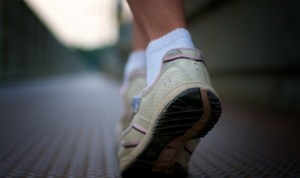 Cara Lewis, an assistant professor of physical therapy at Boston University, spends a lot of time watching people walk, and worrying about how their hips will function later in life. Lewis is convinced that if people walked properly, the stress on their hips and knees could be greatly reduced, and the number if hip replacements (now 320,000 a year) and knee replacements (670,000 a year) would follow suit. Bostonians can visit her lab, suit up in what she calls a robotic hip exoskeleton, and get a computer aided analysis of their stride. The rest of us will have to rely on Lewis’ advice, published in the Boston Globe:
Cara Lewis, an assistant professor of physical therapy at Boston University, spends a lot of time watching people walk, and worrying about how their hips will function later in life. Lewis is convinced that if people walked properly, the stress on their hips and knees could be greatly reduced, and the number if hip replacements (now 320,000 a year) and knee replacements (670,000 a year) would follow suit. Bostonians can visit her lab, suit up in what she calls a robotic hip exoskeleton, and get a computer aided analysis of their stride. The rest of us will have to rely on Lewis’ advice, published in the Boston Globe:
WALK SOFTLY As your foot hits – or better, gently contacts – the ground, your knee should be bent a little to absorb the force.
KEEP YOUR PELVIS STABLE This is the “sexy walk may not be good for your joints’’ thing. There shouldn’t be a lot of up and down movement of pelvis or hips .
TAKE SHORTER STEPS Long strides put your joints into more extreme positions, which can injure them over time.
BE SMART ABOUT FOOTWEAR Super high heels, flip-flops – some shoes just aren’t made for walking. If you’re going to be on your feet all day, wear something with less of a heel and more support.
KNEES POINT FORWARD For most, but not all, of us, knees should be pointed forward when walking. If your knees knock together, try using your buttock muscles (gluteals) to keep them pointing forward.
PUSH FORWARD WITH YOUR FEET Don’t pull yourself forward with your hips. It is a subtle distinction, but can make a huge difference.
KEEP SHOULDERS OVER HIPS Stand tall, and keep your shoulders over, not behind, your hips.
REST WHEN YOU’RE TIRED Muscles become less precise as they fatigue. This loss of precision, or klutziness, can lead to injury over time.

SHOULD OF MADE NOTE ABOUT THE NEW FROG LOOKING SHOES AND HOW THEY CAN EFFECT THE FEET.